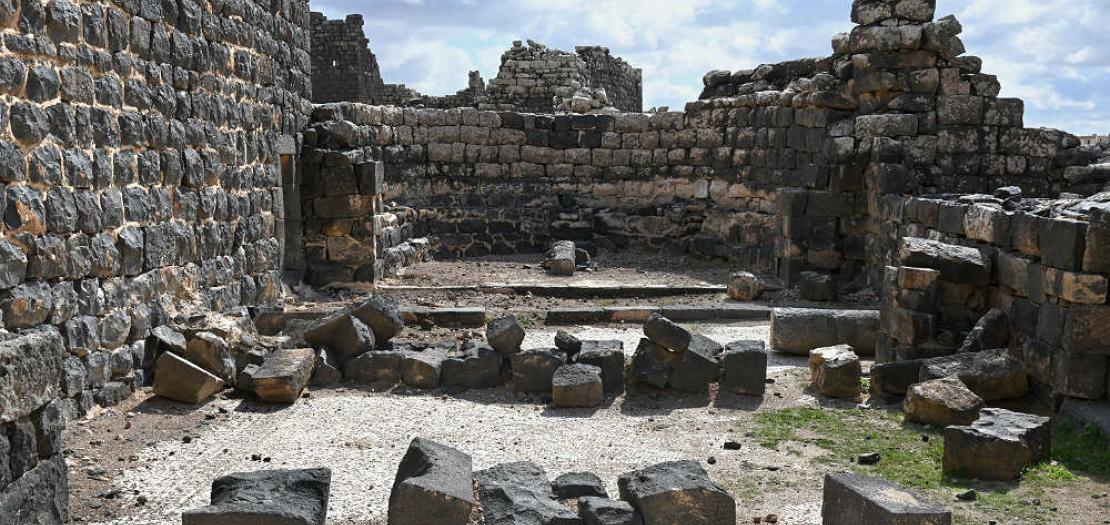Issued by the Catholic Center for Studies and Media - Jordan. Editor-in-chief Fr. Rif'at Bader - موقع أبونا abouna.org
Umm El-Jimal… added on UNESCO World Heritage List
From India, it was announced that Umm El-Jimal was added on the UNESCO World Heritage List. This is not something strange with relevance to the history of Umm El-Jimal, as it was a major center for the resting of caravans, hence the name "Umm El-Jimal" refers to those coming from the East to the Levant and the West, passing through the city of Petra, as many caravans were coming from India, the country from where this announcement was made days ago.
From this premise, when we proudly talk about this charming archaeological city, we are actually talking about a history abounding with civilizations that passed through this place, including of course the small Nabataean Kingdom, which is renowned for its pure water, then the Roman Kingdom, which they called "the Arab Province" and was included among the ten cities called Decapolis. But Umm El-Jimal's pride lies in the fact that it is also a place where 15 churches were built starting from the first centuries of Christianity, as tens of thousands of people and caravans used to pass through it and stay there. Consequently, the church authority had to pay constant attention to the Christians coming to the city, thus it built churches for them and provided them with spiritual services.
The book "Christian Archaeological Sites in Jordan" by Bishop Salim Al-Sayegh, who will soon celebrate his 90the birthday, may God prolong his life, mentions that in the year 557 a historic event took place in the city of Umm El-Jimal, namely the inauguration of the city's cathedral. Later, the participating delegations came from various neighboring dioceses in Jordan, Syria and Palestine. Umm El-Jimal was at that time at the pinnacle of its glory and power. A total of 15 churches were located in the city of Umm El-Jimal, which indicates the flourishing of Christianity, its ancient origins, and the piety of its people. According to the book, the oldest church was the Church of Julian which dates back to the year 345AD. This could be the name of the architect who built it, as is the case with the churches of Claudius and Massachusetts and Massichus, or the name of the generous benefactor who donated funds to build it.
In the Byzantine era, the military barracks were transformed into monasteries and are now called "monasteries", as indicated by the inscription found on the tower on its southeastern corner. The 16-meter high tower has six floors, and a balcony protrudes on its four sides, bearing the name of one of the archangels, namely Gabriel, Michael, and Raphael. Among its most prominent churches is the western church which is located near the Gate of Commodus. Its main entrance is about 24 meters long, and its nave is about 22 meters long and 16 meters wide. Next to the altar, there are two arches with two crosses engraved on them. The church is surrounded by two porticoes from the north and south, and between the nave and the porticoes there are two rows of arches. As for the rest of the churches, some take the form of a large hall, and some contain portico in the center separated from the side porticoes by arches standing on bases. It is worthy to note that during the Umayyad era, the construction of churches in Umm El-Jimal did not stop, but rather continued, serving as a sign of human partnership and mutual acceptance between the Christian and Islamic religions.
I recall that in 2018, we celebrated a Holy Mass there attended by about a thousand people, which marked the inauguration of the beautiful and new era of this city which welcomed that year several religious leaders including Cardinal Bishara Rai who celebrated Holy Mass there. At this point, we convey gratitude for the efforts made by the Ministry of Tourism and Antiquities, the Jordan Tourism Board, and the Umm El-Jimal Municipality, whose former mayor Hasan Al-Rahibah won the award in New York for the most active mayor.
We are proud of these successive achievement with relevance to our dear religious tourism, namely the addition of Umm El-Jimal to the World Heritage List and including its six sisterly site, which had been added to the list, the last of which was Salt, and before that were Petra, Qusayr Amra, Umm al-Rasas, Wadi Rum, and the Baptism Site. These are great efforts being made, and we hope that the Almighty Lord will instill an atmosphere of security and stability so that tourism can flourish again, just as had been in the early ages and at the emergence of Umm El-Jimal, so that it may remain a center for pilgrims coming from the East and West of the world, take rest in this "dark-stoned" city, and take pride in its deep-rooted history.







